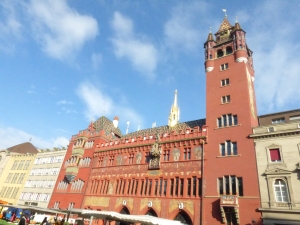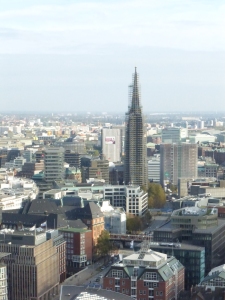Hello friends and family,
I hope you enjoyed a restful Thanksgiving filled with lots of turkey and gratitude. I unfortunately did not have turkey here in France, but I managed to celebrate Thanksgiving in other ways. I’ll get to that though. I have a feeling this is going to be a massively long blog post, but hey, you are all on Thanksgiving break, so you have no excuse not to read the whole thing.
So, where was I? Oh right, my second week in Germany, which was now about a month ago. Once I returned from Hamburg, I visited several different cities in Germany and one in the Netherlands. I’ll give a brief overview of each of them.
Ösnabrück- October 26th
The day that I left Hamburg, I met up with my roommate Anne-Marie in the quaint town of Ösnabrück, where her boyfriend, Jan, goes to law school. Jan graciously showed us around the town, which has quite a few ancient buildings. Unfortunately much of it was bombed during World War II. It’s most well-known as the site of a treaty that ended the Thirty Years’ War, a war between Catholics and Protestants back in the 1600’s. Ösnabrück was the main Protestant hold, while another city that I visited later in the week, Münster was where the Catholics signed the same peace treaty. We went into the town hall in Ösnabrück and sat in the salon where the dignitaries from the Protestants signed the peace treaty. I’m not that familiar with European history, but I could appreciate the historical significance of this treaty, which was the last major religious war between Protestants and Christians in Europe. It’s possible that some of my ancestors fought and died in the war or were otherwise affected, since I know that some of my family came from Germany and my family is Lutheran. While I was in Ösnabrück, I also learned about a peculiar tradition in Northern Germany: when a single man turns 30, he has to sweep the steps of his local town hall while women cheer him on, and the only way he can be freed of this task is to receive a kiss. A little strange, I know.
That also reminds me, of something I forgot to mention when I was talking about hanging out in Cologne. Apparently, in Cologne, on the first day, it’s a tradition for men to give their girlfriend a branch from a birch. Somehow this spiraled out of control, and in recent years, men have been carrying entire birch trees to their girlfriends to prove their love.
But I digress. So after Jan showed us around, Anne-Marie and I headed back to her house in Gladbeck, where I spent the rest of the week. But I also made plenty of day trips around the area.
Duisburg- October 27th
On Monday of that week, Anne-Marie, her parents, and I went to Duisburg, a nearby city in the Ruhrgebiet, which is the largest inland port in the world. We walked around the river banks, which were flanked by industrial-looking buildings and nice restaurants. It reminded me of Jack London Square in Oakland. Then, we took a riverboat tour of the port, which was quite cool. Unfortunately, the narration was only in German, but Anne-Marie translated a lot of it for me.
Winterswijk, the Netherlands- October 28th
The next day, we took a day trip to the Netherlands. Because you can do that in Germany. Anne-Marie only lives about one hour from the border. We drove to Winterswijk, which is a cute little town right near the frontier in a more agricultural area. There wasn’t much to do there except for shop. This was the first time I had been in the Netherlands since I went to Rotterdam when I was thirteen, but seeing the Dutch language felt familiar. By that time in my trip, I was so accustomed to seeing German everywhere, and I had started recognizing some words, so trying to read the Dutch left me puzzled.
Düsseldorf- October 29th
I went on a day trip to Düsseldorf, which I found to be a rather dreary city. Maybe I just got that impression because it was drizzling the whole time I was there. I walked around the city, saw its famous shopping street, Königsallee, which has really overpriced stores, briefly visited its Old Town, took a stroll by the Rhine, and then decided I had seen enough. I then took a tram out to the Neanderthal Museum, which is located in a Valley where one of the first Neanderthal skeletons was discovered. I had a blast there, seeing the exhibit and learning about Neanderthals and early modern humans. I love that kind of stuff. Did you know, for example, that Neanderthals probably had language capacity, since their voice box has the same form as ours? And that early modern humans flossed their teeth with twigs or whatever was available? It was a really fun museum, with plenty of Neanderthal wax figures. I highly recommend it.
Münster- October 30th
I visited Münster with Anne-Marie, because she went to the university there and needed to turn in some paperwork for completing her masters. Münster was one of my favorite cities in Germany. It has a college town feel. There are tons of young people everywhere, and everyone rides bikes. I almost was hit by bicyclists like three or four times in the single day we were there. We hung out at the university, which has a château as one of its main buildings. Apparently, it’s pretty common for universities to have châteaus on their campus in Germany, because there was one at Ösnabrück too (but the one at Münster was bigger). We walked around a quiet lake right in the middle of the city, and we also explored the downtown area, which has magnificent architecture. Münster is known for a particular type of roof, which has steps on it. Apparently most of its old buildings were also destroyed in the war, but since Münster has a rich population, they were able to reconstruct most of its buildings anew. The city had an energetic vibe, and it seemed like it would be a great location for students.
The rest of my break, I spent with Anne-Marie and her family in Gladbeck. They were so nice to let me stay with them for two whole weeks! It’s been a month, and I can’t wait until I get another chance to go back to Germany. I had a fantastic time exploring it. Despite whatever stereotypes exist of Germans, everyone I met in Germany was extremely kind and helpful and totally understanding of the fact that I didn’t speak German. I had a fantastic time there.
So what have I been up to since then, in the past month? Well, I’ve been working, doing NaNoWriMo (which I finished! yay!), and also exploring the region of Europe where I live.
On Veteran’s Day, November 11, which was Armistice Day here in France, I went to Basel, Switzerland for the day. I loved the city, which is built on a hill and has an interesting mix of French, German, and Swiss culture. Anne-Marie and I basically wandered around it the entire day. The city has gorgeous architecture, views of the Rhine, an incredible cathedral, and a striking town hall painted red with ornate designs. I plan on going back to Basel, since it’s only an hour away by train, so you’ll hear more about it at some point.
Two weekends ago, on November 15, I went to Belfort, France, with another English teaching assistant, my friend Fraser, who is from Scotland. We met up with one of his Scottish friends, another teaching assistant, who lives in Belfort. Belfort is technically part of a different region of France: France Comté, which is known for its cheese, but it’s directly on the border of Alsace. In fact, I actually live very close to Belfort. I am only 25 minutes away from it by train. We checked out Belfort’s Citadel, its most well-known landmark, which dates back to the middle ages. Belfort was under siege during the Prussian War in the 19th Century, and when the Prussians won, Alsace was incorporated into Germany. Belfort, however, refused to be annexed, because it was mostly French-speaking, so it became the border of France at the time. As a result, Belfort’s architecture looks more French than the buildings here in Alsace. Its downtown has 19th Century buildings that look like ones you might find in Paris or Lyon. Belfort also is famous for its statue, “The Lion of Belfort” by the sculptor Bartholdi. Does his name sound familiar? It’s probably because he’s the sculptor who designed the Statue of Liberty. “The Lion of Belfort” was created to commemorate the siege of Belfort during the Prussian War.
Finally, last but not least, here’s how I spent my Thanksgiving in France:
On Tuesday, November 25, two of the teachers who are in charge of advanced English and History classes (some of which are taught in English) invited me to a Thanksgiving luncheon that their students were making. It was truly a diverse potluck of dishes that were “American” in some way or another. I had sweet potatoes (sadly no marshmallows on top, although I told the teacher who made it that the marshmallows were an essential ingredient), cornbread, Chinese-style salad, boiled potatoes, pumpkin soup, and pie (lots of pie). Sadly, there was no turkey, but it would have been difficult to cook and then bring to school, so I understood. It wasn’t your typical Thanksgiving meal, but it was quite enjoyable, all the same.
Then, yesterday, on actual Thanksgiving, I spent my day at the foire de Saint-Catherine (the fair of St. Catherine). I was lucky that Altkirch happens to have its own local holiday on November 27, so I didn’t have to work. Instead, I watched as my normally sleep French town went into full-on market mode for the fair. The fair, which was in its 513th year, was originally for peasants to sell their livestock, harvest, and other agricultural products. Now, the main attraction is its tractors and farming equipment. There were also stands selling all sorts of things: local honey, soap, Christmas ornaments, crêpes, even churros, and my favorite: vin chaud (mulled wine). It was quite a site to see the normally deserted streets transformed into a bustling market. There was also an area just for livestock, where I was able to pet horses, ponies, and goats. There were chickens too, but I didn’t feel like petting them.
That about sums up my past month in France. I’m so grateful to be here and to be pushing myself out of my comfort zone while I travel and have adventures. I’m visiting another city in Alsace this upcoming weekend, Colmar, where the Christmas market is now open. So expect to here more about that soon!
Here are some more pictures from Basel, because it was an especially beautiful city:











































